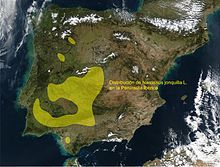Map Snapshot

0 Records
Status
Daffodil species have long been popular garden plants. The plants naturalize locally and persist at old home sites for decades. Patches of daffodils may be found in woods or at the edges of fields and roadways throughout Maryland. Daffodils have also naturalized in floodplains where they may be dispersed by flood waters.
Seasonality Snapshot
No Records
No images available
Source: Wikipedia
| Jonquil or Rush daffodil | |
|---|---|

| |
| Scientific classification | |
| Kingdom: | Plantae |
| Clade: | Tracheophytes |
| Clade: | Angiosperms |
| Clade: | Monocots |
| Order: | Asparagales |
| Family: | Amaryllidaceae |
| Subfamily: | Amaryllidoideae |
| Genus: | Narcissus |
| Species: | N. jonquilla
|
| Binomial name | |
| Narcissus jonquilla | |

| |
| Distribution range on the Iberian Peninsula | |
| Synonyms | |
| |
Narcissus jonquilla, commonly known as jonquil[3] or rush daffodil, is a bulbous flowering plant, a species of the genus Narcissus (daffodil) that is native to Spain and Portugal but has now become naturalised in many other regions: France, Italy, Turkey, the former Yugoslavia, Madeira, British Columbia in Canada, Utah, Illinois, Minnesota, Ohio, and the southeastern United States from Texas to Maryland.
Narcissus jonquilla bears long, narrow, rush-like leaves (hence the name jonquil, Spanish junquillo, from the Latin juncus 'rush').[4][5] In late spring it bears heads of up to five scented yellow or white flowers. It is a parent of numerous varieties within Division 7 of the horticultural classification.[6] Division 7 in the Royal Horticultural Society classification of Narcissus includes N. jonquilla and N. apodanthus hybrids and cultivars that show clear characteristics of those two species.[7][8]
N. jonquilla has been cultivated since the 18th century in France as the strongest of the Narcissus species used in narcissus oil, a component of many modern perfumes.[4]
Notes
[edit]- ^ Lansdown, R.V.; Caldas, F.B.; Moreno Saiz, J.C. (2017) [errata version of 2017 assessment]. "Narcissus jonquilla". IUCN Red List of Threatened Species. 2017: e.T175237A115717890. doi:10.2305/IUCN.UK.2011-1.RLTS.T175237A7127291.en. Retrieved 20 July 2024.
- ^ The Plant List
- ^ BSBI List 2007 (xls). Botanical Society of Britain and Ireland. Archived from the original (xls) on 2015-06-26. Retrieved 2014-10-17.
- ^ a b Nigel Groom (30 June 1997). The New Perfume Handbook. Springer. pp. 170–171. ISBN 978-0-7514-0403-6. Retrieved 28 July 2012.
- ^ Shorter Oxford English dictionary, 6th ed. United Kingdom: Oxford University Press. 2007. p. 3804. ISBN 978-0199206872.
- ^ RHS A-Z encyclopedia of garden plants. United Kingdom: Dorling Kindersley. 2008. p. 1136. ISBN 978-1405332965.
- ^ Gordon R. Hanks (18 April 2002). Narcissus and Daffodil: The Genus Narcissus. CRC Press. p. 50. ISBN 978-0-415-27344-2. Retrieved 26 July 2012.
- ^ "RHS Plant Selector - Narcissus jonquilla". Archived from the original on 8 April 2014. Retrieved 27 June 2013.

